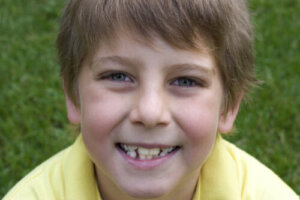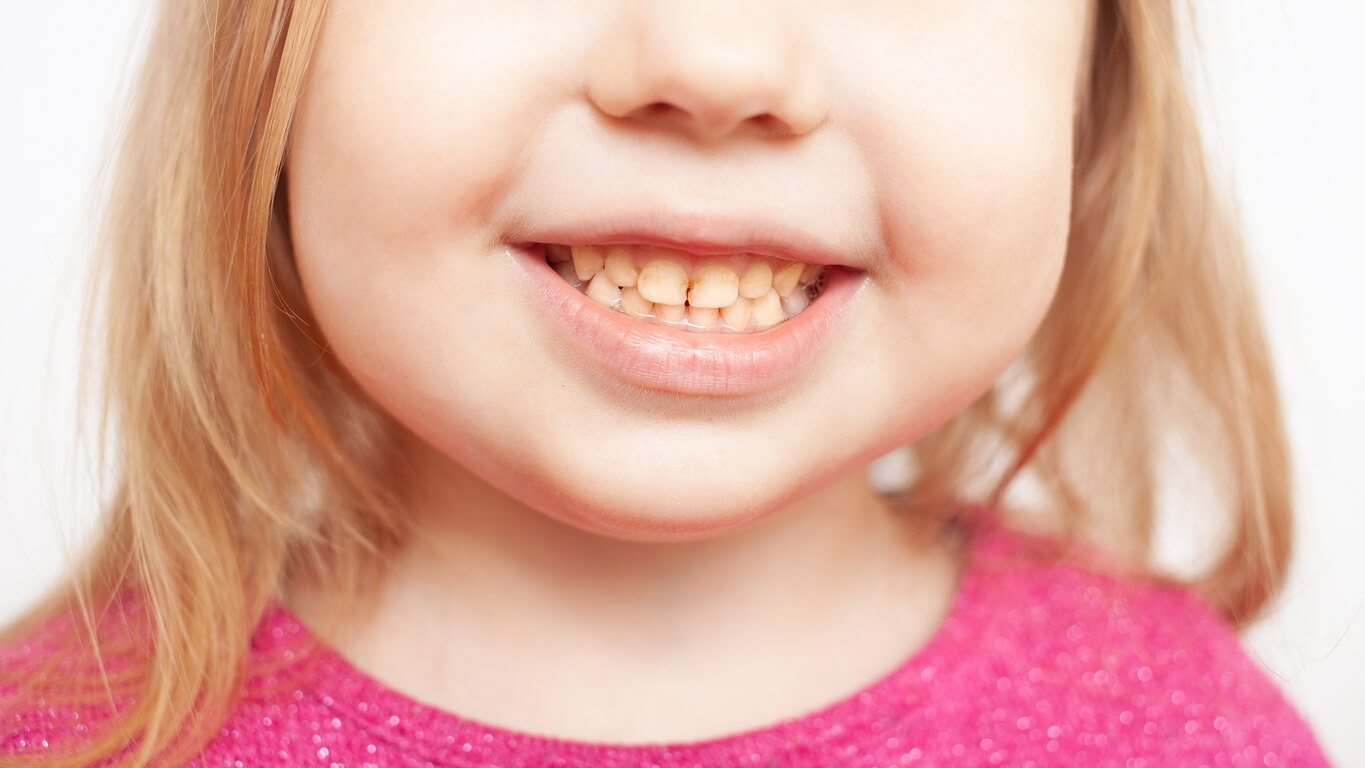My Child's New Teeth Are Yellow, Is This Normal?


Written and verified by the dentist Vanesa Evangelina Buffa
The radiant smiles we see on TV or on celebrities can lead us to believe that all teeth should look that white. So, if you notice that your child’s new teeth are yellow, you may be concerned. In some cases, this coloration is a wake-up call that you shouldn’t overlook. But other times, it’s due to a natural phenomenon that shouldn’t cause alarm. Discover here the reasons why your child’s new teeth may look yellow.
The natural color of teeth
The first thing to know is that we all have our own tooth color. Just as there are different colors of eyes, skin, and hair, there are also different shades of teeth. This variation means that some people have whiter teeth and others have more grayish or yellowish tones. This doesn’t automatically imply that teeth with a darker tone are the result of poor hygiene or are stained.
The reason for these different shades is the composition of the teeth. The crown of the teeth, which is the portion we see in the mouth, is made up of 3 layers, which from the outside in are the enamel, dentin, and pulp. Each one of them has a certain thickness. The combination of these thicknesses gives rise to the different shades.
The enamel is the outermost part of the tooth and is characterized by being translucent. Therefore, it reveals the dentin underneath, which has a more yellowish color. Thus, people with a thicker enamel layer have whiter teeth. On the other hand, when the outer layer is thinner, more underlying tissue is visible and the teeth appear darker. So, one of the reasons your child’s new teeth look yellow may be that this is their natural coloring.

Baby teeth are whiter than permanent teeth
It’s very common for parents to believe that their child’s new teeth are yellow when the tooth replacement season begins. But in reality, this sensation is due to an optical phenomenon. Since the baby teeth are much whiter than the permanent ones, this color contrast makes the definitive elements appear too dark when compared to the temporary ones.
The crowns of baby teeth have the three layers we told you about. The mineralization of the hard tissues is different than in permanent teeth and the layers are thinner. This gives the temporary teeth a whiter appearance. In fact, the white aspect of these teeth resembles the color of milk, which is one of the reasons why they’re also known as milk teeth.
On the other hand, permanent teeth have more time for the formation and mineralization of their crown. The enamel and dentin layers are thicker, so their color is darker. In addition, when some temporary teeth come out and the definitive ones emerge, the differences in shades become evident. This happens because of the proximity of the older, whiter teeth to the new, yellower ones.
Other causes why your child’s new teeth are yellow
Having clarified these two normal situations that can cause your child’s new teeth to look yellow, let’s look at other possible causes of the coloration:
- Poor oral hygiene: When tooth brushing is insufficient or not done correctly, bacterial plaque accumulates on tooth surfaces. If plaque persists over time, it can calcify and turn into tartar, which is very noticeable because of its dark yellow color.
- Trauma: If your child suffered a blow to the tooth, the trauma can cause damage to the pulp that results in a change of color in the crown. This is an internal stain that isn’t removed with brushing. First, the tooth looks yellow and then turns brown or black.
- Medications: The use of certain medications during gestation or in the child’s early childhood can stain the teeth yellow or brown. The most common example is tetracyclines.
- Fluorosis: Chronic exposure to high concentrations of fluoride during tooth formation causes discoloration of the teeth. This condition may manifest as yellow stains.
- Hypoplasias: This is a defect in the development of enamel during its formation. This condition can be seen on the teeth as white or yellow spots, dots, or stripes.
- Caries: This disease can manifest itself as yellow stains on the teeth.

Tips to prevent your child’s new teeth from looking yellow
If your child’s new teeth look yellow because that’s their natural color or it’s just an optical illusion due to the contrast with the milk teeth, there’s nothing you need to do. However, this coloring can also be due to the accumulation of bacterial plaque, tartar, or cavities.
To prevent your child’s new teeth from becoming covered with bacteria, stained, or diseased, you should take care of them. With a few simple practices, you can keep them clean and healthy. To do so, keep the following tips in mind:
- Maintain proper oral hygiene: Brushing teeth for 2 minutes, 2 times a day, and with the right amount of fluoride toothpaste, is essential to control bacterial plaque. Flossing also prevents debris from collecting in the interproximal areas.
- Watch your diet and reduce sugar consumption: This is another way to prevent children’s teeth from being affected. By limiting sweet foods, the proliferation of bacteria is reduced, the appearance of caries is avoided, and damage to the enamel is reduced.
- Visit the pediatric dentist every 6 months: The professional will be able to detect any problems that appear early and treat them in a timely manner.
Teeth forever
If your child’s new teeth look yellow, it’s most likely due to the difference in color in comparison with the milk teeth that are still in the mouth. This perception isn’t something to be alarmed or worried about, as it will cease to be noticeable when the tooth replacement is complete. In any case, you shouldn’t neglect the hygiene and care that the new teeth need to stay healthy and clean. Remember that these elements should last in your child’s mouth for life.
The radiant smiles we see on TV or on celebrities can lead us to believe that all teeth should look that white. So, if you notice that your child’s new teeth are yellow, you may be concerned. In some cases, this coloration is a wake-up call that you shouldn’t overlook. But other times, it’s due to a natural phenomenon that shouldn’t cause alarm. Discover here the reasons why your child’s new teeth may look yellow.
The natural color of teeth
The first thing to know is that we all have our own tooth color. Just as there are different colors of eyes, skin, and hair, there are also different shades of teeth. This variation means that some people have whiter teeth and others have more grayish or yellowish tones. This doesn’t automatically imply that teeth with a darker tone are the result of poor hygiene or are stained.
The reason for these different shades is the composition of the teeth. The crown of the teeth, which is the portion we see in the mouth, is made up of 3 layers, which from the outside in are the enamel, dentin, and pulp. Each one of them has a certain thickness. The combination of these thicknesses gives rise to the different shades.
The enamel is the outermost part of the tooth and is characterized by being translucent. Therefore, it reveals the dentin underneath, which has a more yellowish color. Thus, people with a thicker enamel layer have whiter teeth. On the other hand, when the outer layer is thinner, more underlying tissue is visible and the teeth appear darker. So, one of the reasons your child’s new teeth look yellow may be that this is their natural coloring.

Baby teeth are whiter than permanent teeth
It’s very common for parents to believe that their child’s new teeth are yellow when the tooth replacement season begins. But in reality, this sensation is due to an optical phenomenon. Since the baby teeth are much whiter than the permanent ones, this color contrast makes the definitive elements appear too dark when compared to the temporary ones.
The crowns of baby teeth have the three layers we told you about. The mineralization of the hard tissues is different than in permanent teeth and the layers are thinner. This gives the temporary teeth a whiter appearance. In fact, the white aspect of these teeth resembles the color of milk, which is one of the reasons why they’re also known as milk teeth.
On the other hand, permanent teeth have more time for the formation and mineralization of their crown. The enamel and dentin layers are thicker, so their color is darker. In addition, when some temporary teeth come out and the definitive ones emerge, the differences in shades become evident. This happens because of the proximity of the older, whiter teeth to the new, yellower ones.
Other causes why your child’s new teeth are yellow
Having clarified these two normal situations that can cause your child’s new teeth to look yellow, let’s look at other possible causes of the coloration:
- Poor oral hygiene: When tooth brushing is insufficient or not done correctly, bacterial plaque accumulates on tooth surfaces. If plaque persists over time, it can calcify and turn into tartar, which is very noticeable because of its dark yellow color.
- Trauma: If your child suffered a blow to the tooth, the trauma can cause damage to the pulp that results in a change of color in the crown. This is an internal stain that isn’t removed with brushing. First, the tooth looks yellow and then turns brown or black.
- Medications: The use of certain medications during gestation or in the child’s early childhood can stain the teeth yellow or brown. The most common example is tetracyclines.
- Fluorosis: Chronic exposure to high concentrations of fluoride during tooth formation causes discoloration of the teeth. This condition may manifest as yellow stains.
- Hypoplasias: This is a defect in the development of enamel during its formation. This condition can be seen on the teeth as white or yellow spots, dots, or stripes.
- Caries: This disease can manifest itself as yellow stains on the teeth.

Tips to prevent your child’s new teeth from looking yellow
If your child’s new teeth look yellow because that’s their natural color or it’s just an optical illusion due to the contrast with the milk teeth, there’s nothing you need to do. However, this coloring can also be due to the accumulation of bacterial plaque, tartar, or cavities.
To prevent your child’s new teeth from becoming covered with bacteria, stained, or diseased, you should take care of them. With a few simple practices, you can keep them clean and healthy. To do so, keep the following tips in mind:
- Maintain proper oral hygiene: Brushing teeth for 2 minutes, 2 times a day, and with the right amount of fluoride toothpaste, is essential to control bacterial plaque. Flossing also prevents debris from collecting in the interproximal areas.
- Watch your diet and reduce sugar consumption: This is another way to prevent children’s teeth from being affected. By limiting sweet foods, the proliferation of bacteria is reduced, the appearance of caries is avoided, and damage to the enamel is reduced.
- Visit the pediatric dentist every 6 months: The professional will be able to detect any problems that appear early and treat them in a timely manner.
Teeth forever
If your child’s new teeth look yellow, it’s most likely due to the difference in color in comparison with the milk teeth that are still in the mouth. This perception isn’t something to be alarmed or worried about, as it will cease to be noticeable when the tooth replacement is complete. In any case, you shouldn’t neglect the hygiene and care that the new teeth need to stay healthy and clean. Remember that these elements should last in your child’s mouth for life.
All cited sources were thoroughly reviewed by our team to ensure their quality, reliability, currency, and validity. The bibliography of this article was considered reliable and of academic or scientific accuracy.
- Lafuente, D. (2008). Física del Color y su utilidad en Odontología. Revista Científica Odontológica, 4(1), 10-15.
- Pereira, Y. S., Salas, M. E., & Espinoza, N. (2011). PREVALENCIA DE FLUOROSIS DENTAL, OPACIDADES E HIPOPLASIA DEL ESMALTE EN NIÑOS EN EDAD ESCOLAR. odontologia, 6, 2.
- CARRASCO MORALES, MARIA BELÉN. Fluorosis dental infantil. BS thesis. Universidad de Guayaquil. Facultad Piloto de Odontología, 2021.
- Ponce Icarayme, J. (2018). Lesiones pigmentantes dentarias en niños de 6 a 8 años de edad del centro de salud Huanipaca Marzo a Junio 2017.
- de la Torre Mendoza, I. (2018). Prevalencia de hipoplasia del esmalte en niños de 6 a 12 años de un centro educativo de la ciudad de Lima.
- Trancho, G. J., & Robledo, B. (2000). Patología Oral: Hipoplasia del esmalte dentario. Madrid: Departamento de Biología Animal (Antropología), Facultad de Biología, Universidad Complutense de Madrid.
- Pin Vélez, Jéssica Alexandra. Prevalencia de caries en dientes temporales. BS thesis. Universidad de Guayaquil. Facultad Piloto de Odontología, 2020.
- Sánchez, T. B., Avila, J. O. T., Segueo, M. S., & Gil, L. P. (2016). Traumatismos dentarios en niños y adolescentes. Correo Científico Médico de Holguín, 20(4), 741-756.
This text is provided for informational purposes only and does not replace consultation with a professional. If in doubt, consult your specialist.








